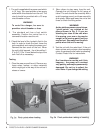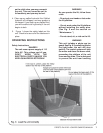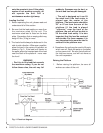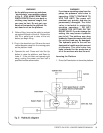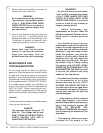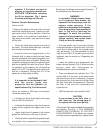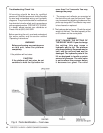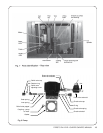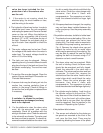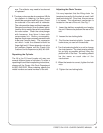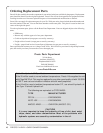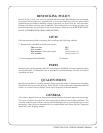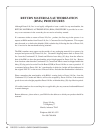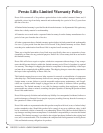
14 PRESTO P4 LEVEL LOADER OWNER’S MANUAL
valve has been included for the
protection of all of the workers who
use the unit.
3. If the motor is not running, check the
electrical plug, the circuit breaker or fuse,
and the wiring to the motor.
4. The hydraulic oil level may be low. In order to
check the level, lower the unit completely
and unplug the power cord. Remove the rear
cover on the unit. When the platform is
lowered as far as possible, the oil should
be about 1/2’’ to 3/4’’ inch below the top of
the tank. Remove the red plastic plug on
top of the tank. Use a dipstick to check the
oil level.
5. The motor voltage may be too low. Check
the voltage at the starter when the motor is
under load. The supply voltage should be
within ±10% of the rating.
6. The tank vent may be plugged. Before
operating the unit, you must remove the solid
plug from the top of the tank and insert the
red plastic vented plug. The vent line must
be clear.
7. The suction filter may be clogged. Clean the
suction filter as described in the section on
“Periodic Maintenance.”
8. A vacuum leak may be allowing air into the
suction line, causing cavitation (loss of
suction) in the pump. Check all fittings in
the suction line, and tighten or replace them
if necessary.
CAUTION!
If cavitation is allowed to continue,
the pump may be damaged, and may
have to be replaced.
9. For the platform to raise, the down valve
must be de-energized and closed
completely. Check for a problem with the
wiring to the down valve. Check the solenoid
in the valve with a voltmeter. The valve must
be clean and free to operate. To check this,
remove the solenoid and then the valve. Look
for dirt or metal chips which could block the
valve action. Clean the valve plunger with
kerosene, then blow it clean with
compressed air. The expansion nut which
holds the solenoid should be finger tight
only).
10. If the pump has been changed, the coupling
may not have been installed between the
motor and pump. See the pump assembly
in Fig. 8.
If the platform elevates, but fails to hold a load:
1. The check valve may be leaking. Dirt on the
valve seat can prevent the valve from
closing fully. The check valve is mounted in
the base of the pump housing, as shown in
Fig. 8. Remove the check valve cap and
inspect the valve for dirt or metal chips
which may be preventing it from closing. You
may be able to restore the seal by lightly
rapping the ball into the seat using a 1/4"
diameter rod and a small hammer.
2. The down valve may be energized. While
the unit is holding a load, the down valve
should be de-energized and fully closed.
Check the solenoid in the valve with a
voltmeter. The valve must be clean and free
to operate. To check this, remove the
solenoid and then the valve. Look for dirt or
metal chips which could block the valve
action. Clean the valve plunger with
kerosene, then blow it clean with
compressed air. The expansion nut which
holds the solenoid should be finger tight only!
3. The cylinder may be leaking. Look for oil on
the cylinder rod and in the vent line. (This
may also occur if the oil tank has been over-
filled.) If you find much oil in either place,
and the tank is not over-filled, the cylinder
must be repacked. See the section in this
manual on “Repacking the Cylinder.”
If the platform fails to lower:
1. The sensor and reflector for the photo eye
toe guard are mounted at the front of the
unit, near the floor level. There may be
something blocking the beam of the photo




